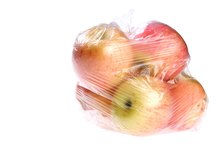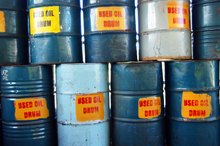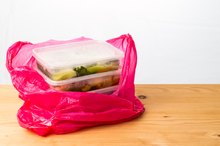What does fact checked mean?
At Healthfully, we strive to deliver objective content that is accurate and up-to-date. Our team periodically reviews articles in order to ensure content quality. The sources cited below consist of evidence from peer-reviewed journals, prominent medical organizations, academic associations, and government data.
The information contained on this site is for informational purposes only, and should not be used as a substitute for the advice of a professional health care provider. Please check with the appropriate physician regarding health questions and concerns. Although we strive to deliver accurate and up-to-date information, no guarantee to that effect is made.
What Are the Dangers of Plastic Food Storage Containers?
Plastic food storage containers don't cost a lot, are light and durable and are easily found in most stores. Despite their advantages for storing dinner leftovers and other food items, such plastic food containers can present several dangers. These dangers and risks run a wide gamut ranging from health risks to you and your family, to environmental degradation.
Microwave Degeneration
Some plastic food containers are not formulated to withstand the effects of being heated in a microwave oven. The United States Department of Agriculture Food Safety and Inspection Service warns that such containers can melt or warp in the heat. Additionally, the USDA says various kinds of harmful chemicals can end up in your food if you put a non-microwave-safe plastic container in a microwave.
Bisphenol A
Health Concerns for Silicone Ice Trays Vs. Plastic Ice Trays
Learn More
Companies use a chemical known as Bisphenol A, commonly referred to as BPA, to manufacturer reusable plastic food containers, according to Pennsylvania State University. The university warns that research is inconclusive on the safety of this chemical, but reports that some potential exists for numerous health risks related to BPA exposure. The United States Department of Health & Human Services warns that the most risk involves children and infants who are more susceptible to trace amounts of any type of chemical 1.
Harbors Bacteria
Some plastic food containers may be hard to clean or have grooved or lipped surfaces that harbor bacteria, according to the International Association for Food Protection. The bacteria may contaminate the food itself and create a risk of gastrointestinal distress or food poisoning. The association recommends only using plastic food storage containers that are wide, open and easy-to-clean.
Environmental Effects
Negative Effects of Packaging
Learn More
In 2008, American households discarded 13 million tons of plastic, according to the U.S. Environmental Protection Agency 2. Of these, most of the plastic was from containers. The EPA reports that only 6.8 percent of this plastic was recycled. The throwing away of plastic can contaminate the environment and build-up in landfills.
- In 2008, American households discarded 13 million tons of plastic, according to the U.S. Environmental Protection Agency 2.
- The EPA reports that only 6.8 percent of this plastic was recycled.
Heat-Based Chemical Leaching
Exposing plastic containers to high heat conditions, such as boiling water or a dishwasher, can cause the plastic to leach various kinds of potentially harmful chemicals into its food contents, according to the U.S. Department of Health & Human Services 1. This includes BPA. The department suggests not using boiling water with plastic containers, and only placing plastic containers labeled "dishwasher-safe" in your dishwashing appliance.
Related Articles
References
Writer Bio
Joshua Duvauchelle is a certified personal trainer and health journalist, relationships expert and gardening specialist. His articles and advice have appeared in dozens of magazines, including exercise workouts in Shape, relationship guides for Alive and lifestyle tips for Lifehacker. In his spare time, he enjoys yoga and urban patio gardening.









